The Banana is a tropical fruit that needs warm temperatures, rich soil, and sunlight to grow properly. Bananas grown in the Philippines are typically small, round, and green, with smooth skin. Bananas are a popular fruit in the Philippines and are grown in many parts of the country.
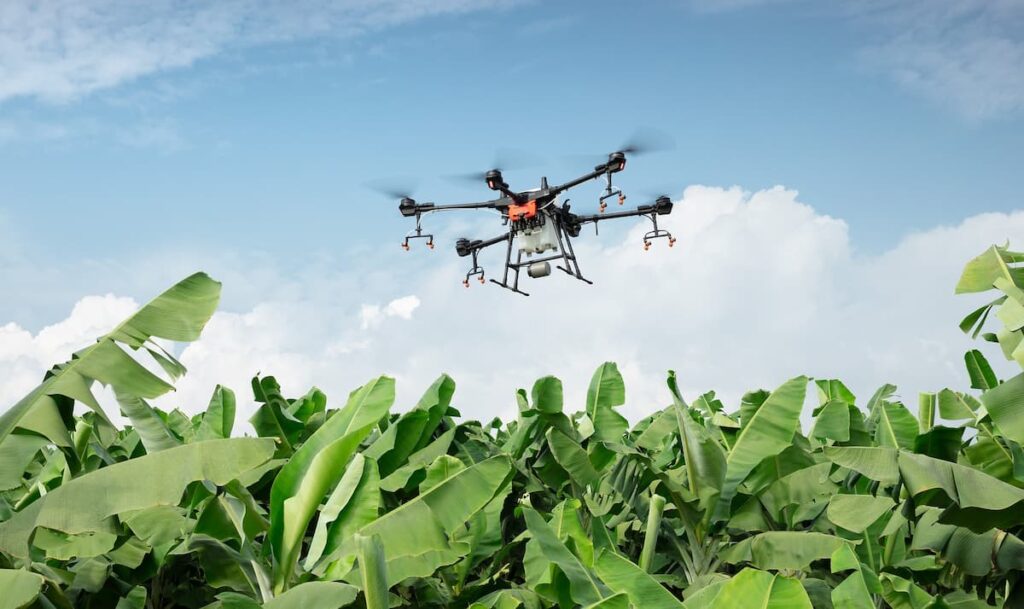
How to start Banana farming in the Philippines
Soil requirement for growing Banana in the Philippines
Three types of soils can be used to grow Bananas in the Philippines: clay, alluvial, and volcanic. Clay soils are best for growing Bananas because they are well-drained and have a high fertility level. Alluvial soils are good for growing Bananas because they are fertile and have a lot of organic matter. Volcanic soils are not good for growing Bananas because they are infertile and contain little organic matter.
Banana growing areas in the Philippines
Banana growing areas in the Philippines can be found in different parts of the country, but they all have one thing in common: fertile soils and hot, humid weather. Therefore, the best places to start a Banana farm in the Philippines are on small islands with stable soils and plenty of sunlight. Good locations for Banana farms include Palawan, Cebu, Negros Oriental, Bohol, Leyte, and Samar.
Some of the best Banana growing regions in the Philippines include Ilocos Norte, Cagayan Valley, Bohol, Negros Oriental, Mindanao, Leyte, and Samar. Bananas can be grown commercially or for subsistence purposes. Commercial Banana production typically involves planting Bananas on large plantations, but subsistence farming is more common, where people grow their Bananas as a food source.
In case you missed it: Organic Banana Farming, Cultivation Practices
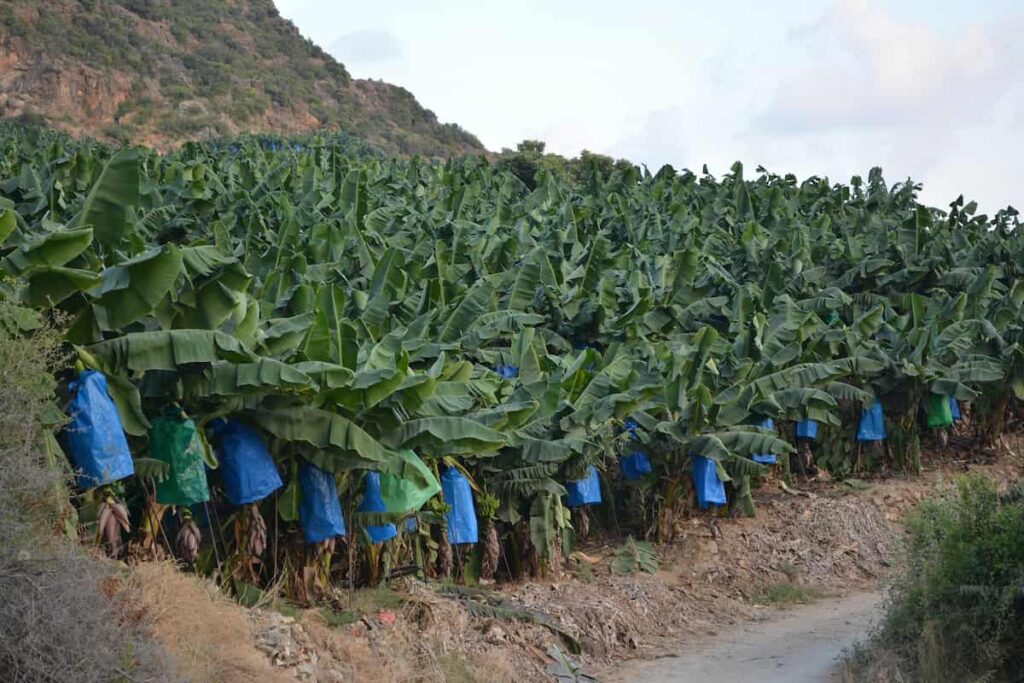
Banana growing conditions in the Philippines
- Banana cultivation in the Philippines begins with a long and arduous selection, propagation, and cultivation process.
- Bananas are propagated through cuttings taken from mature plants. The planting density is 1-1.5 plants per square meter.
- Bananas require full sun and fertile soil to grow, so common garden soils will not do. A pH level of 6 to 7 is ideal for Banana growth. Young plants should be transplanted into prepared Banana trenches 0.3-0.5 meters deep and 2 meters wide at the onset of flowering. These trenches should be covered with clean mud or compost; later on, they can be lined with plastic sheeting to avoid rotting or pests.
- Fertilize once a month during the early stage, then every two weeks as flowering progresses and fruits form; apply balanced fertilizers according to the NPK formula (nitrogen, phosphorus, potassium).
- Water generously during wet periods but withhold water in the dry season for best results. Once ripe, Bananas will fall off the tree naturally; there is no need to remove them manually, as this will only damage them and hasten spoilage.
Banana fertilizer requirements in the Philippines
Bananas are one of the most labor-intensive crops to grow in the Philippines and require a lot of fertilizer to produce healthy plants. Here is a list of the specific Banana fertilizer requirements in the Philippines:
- P2O5: 2 kg/ hectare
- N: 30–60 kg/hectare
- K2O: 3 kg/ hectare
- Mg: 1.5–2 kg/ hectare
The above fertilizers should be applied at planting time with a broadcast spreader. After planting, additional fertilizer may be required every two weeks until harvest, usually occurring six months after planting.
Irrigation management for Banana farming in the Philippines
Irrigation management for Banana farming in the Philippines should be based on a water budget analysis that considers the crop’s needs, soil type, production potential, irrigation infrastructure, and cost. Irrigation can be delivered through surface water or groundwater sources. An irrigation system should have the ability to deliver water at a rate that allows the desired crop yields to be attained without excessive watering or over-watering.
In case you missed it: A Step-By-Step Guide to High-Density Fruit Farming: For Guava, Banana, Mango, Pineapple, Lemon, Papaya, Litchi, and Apple
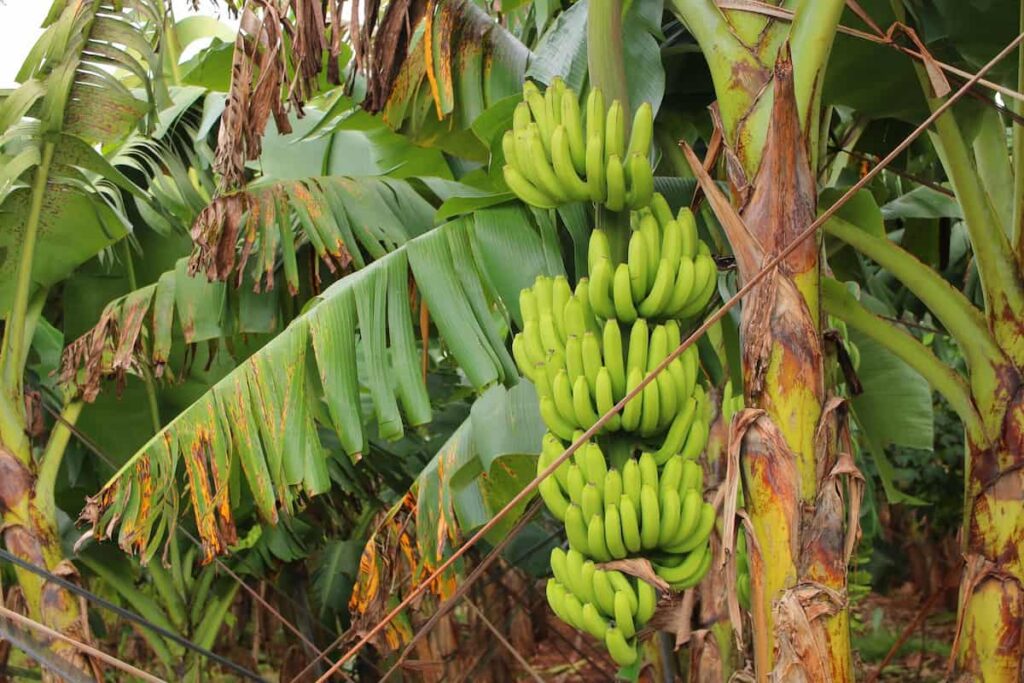
Banana propagation methods in the Philippines
Banana propagation methods in the Philippines vary depending on what type of Banana you’re growing.
- The primary propagation method used for Bananas is by grafting. This process involves cutting off one of the Banana’s branches and inserting it into another tree’s bark near its base. The newly grafted branch will grow roots and be able to transfer nutrients from its parent to itself, and new shoots will form. The Banana is the most commonly grown fruit crop in the Philippines. It is a perennial, frost-sensitive crop that requires warm temperatures and good sunlight. There are several methods used to propagate Bananas. Some of the most common ways are cutting, rooting, and layering.
- Cutting is the simplest propagation method and can be done by simply cutting off a branch or stem from a Banana plant. The cut end must be dipped in rooting hormone before planting to encourage root growth. Planted cuttings should be watered regularly and fertilized as needed.
- Rooting is another common method of Banana propagation. Roots will usually form within two weeks after being planted in moist soil. To root Bananas, dip the tip of the root into rooting hormone, then plant it in moist soil about an inch deep. Water regularly and fertilize as needed.
- Layering is a more complicated propagation method involving taking sections of the stem from young, healthy Banana plants and grafting them together to create new plants. The newly created plants will have the same characteristics as the original Banana plants, including height and fruit production rates. Layering takes time but results in a high success rate when done correctly.
How profitable is Banana farming in the Philippines?
- Banana farming is profitable in the Philippines as long as growers follow the best practices for production. In addition, Banana prices are relatively high in the international market, making this a lucrative crop for farmers.
- Bananas can be grown on a small scale or on a larger scale, and several varieties of Bananas can be grown.
- Small-scale Banana farmers may plant only a few acres of Bananas, while large-scale Banana farmers may plant hundreds of acres. Many different types of Bananas can be grown, such as the Cavendish Banana, one of the most popular varieties in the Philippines.
- The Philippine government supports Banana farmers through programs promoting Banana cultivation and purchasing crops from eligible growers.
Bananas growing as a cash crop in the Philippines
Bananas can be grown in various climates and soils, making them a versatile cash crop. In the Philippines, Bananas are predominately grown in the southern islands of Mindanao and Palawan. Bananas are tropical fruit that requires warm temperatures to grow correctly. In the Philippines, Banana farming is typically done as a subsistence crop. Most Filipinos who farm Bananas do so as their primary source of income. Most Filipinos who farm Bananas do so as their primary source of income. Bananas can be eaten fresh or dried in various sweet and savory dishes.
Banana farming profit per acre in the Philippines
Banana cultivation requires minimal inputs and is highly profitable for smallholders. Therefore, banana farming is a profitable business in the Philippines. The main reason is that Bananas are a seasonal fruit, meaning they only produce fruit during certain periods of the year. This means Banana farmers must be able to plan their production seasons well to ensure a high yield.
Additionally, Bananas are a staple food item in many parts of the Philippines, which means that there is always demand for them. Banana farming is a profitable enterprise in the Philippines. A hectare of Banana land can produce around 3,000 to 4,000 Bananas per year, yielding an average profit of PHP600 to PHP1,200 per acre.
Popular Banana varieties in the Philippines
| Cavendish | Saba |
| Gros Michel | Señorita |
| Lakatan | Morado |
| Latundan | Bungulan |
Most Philippine Banana production takes place on small family farms where farmers grow a limited variety for their consumption or local market. However, there has been an increasing trend towards large-scale Banana production, with some companies producing over 100 million bunches annually. This increase in Banana production has affected prices and availability, with some varieties becoming rare due to over-cultivation and intense consumer demand.
In case you missed it: How to Control Pests and Diseases in Bananas: Causes, Symptoms, Chemical, and Biological Management
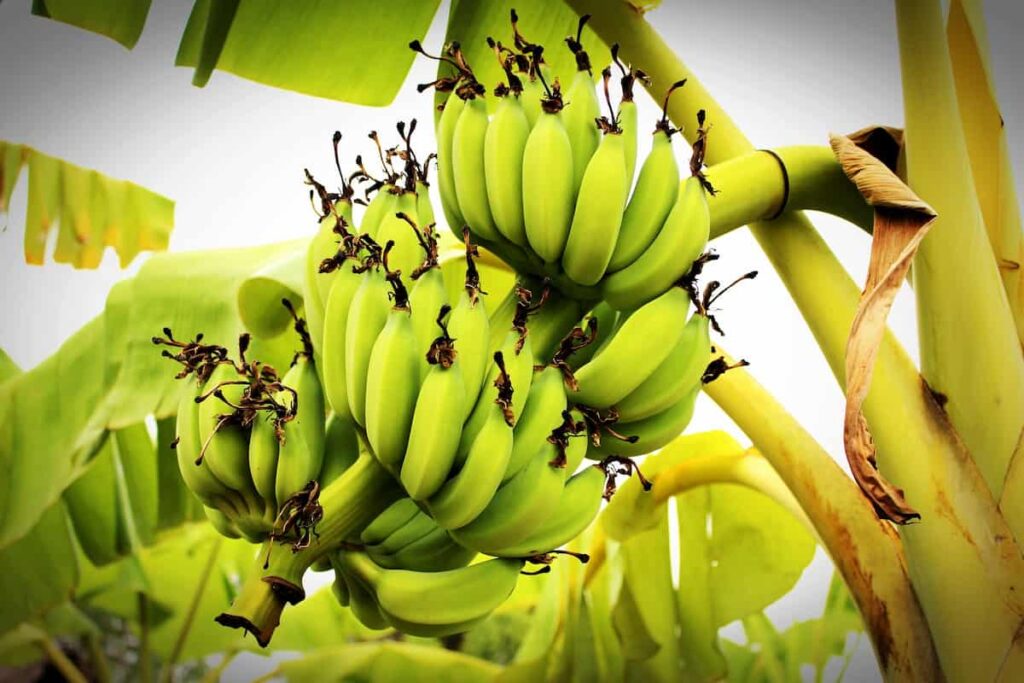
How to start Banana farming in the Philippines?
Banana farming in the Philippines is a great way to get your feet wet in Banana production, learn about the process of Banana cultivation, and make some money. You will need a few things to get started: a plot of land, a tractor or other heavy equipment, irrigation, and Bananas. If you already have some of these things, you are ready to start farming. To begin Banana farming in the Philippines, you will need to find an area conducive to growing Bananas.
In the Philippines, most Banana crops are grown in highland areas that receive between 600 and 1,200 millimeters (24 and 48 inches) of yearly rainfall. You will also need good soil quality and irrigation to grow Bananas successfully. Irrigation can be provided by rainwater or wells, but either way, the water supply must be reliable so that your Banana crop does not suffer from dry spells.
After finding an area suitable for Banana farming in the Philippines, you will need to prepare the ground by tilling it level and removing any rocks or debris. You should add organic matter such as compost or manure before planting your Bananas. When planting your Bananas, choose varieties resistant to pests and diseases. Bananas grow best when planted at a depth of 30 centimeters (12 inches), with a spacing of 60 centimeters (24 inches) between plants. Once your Banana crop has established itself, care must be taken to provide adequate irrigation.
Banana farming business plan in the Philippines
Banana farming is a relatively new business in the Philippines, and there are many opportunities for farmers to start and grow their businesses. However, several factors need to be considered when starting a Banana farming business in the Philippines, including climate, soil quality, availability of resources, and competition from other crops.
To begin Banana farming in the Philippines, potential farmers must assess their local climate and soil quality. Banana growers in the Philippines should also be aware of available resources, such as water and fertilizer, and any existing Banana growing industry in their region. Finally, to compete against other crops in the market, Filipino Banana farmers must develop innovative production techniques that increase yields while using minimal resources.
Major problems of Banana farming in the Philippines
- Banana farming in the Philippines is a major agricultural industry responsible for producing more than two-thirds of the country’s exports. However, Banana farming has several problems that need to be addressed for the industry to grow and improve.
- A major issue facing Banana farmers is soil erosion. The heavy use of fertilizer and pesticides not only leads to excessive plant growth but also results in nutrient loss and soil fertility depletion. This eventually causes soil erosion, reducing the available farmland for other crops.
- Another problem is monkey damage to Banana crops, which can be caused by monkeys raiding the fruit trees for food or gnawing on the branches. There are also problems with pests and diseases affecting Bananas, such as black Sigatoka disease, a fungus that causes leaves to turn brown and fall off, and red steaming spot virus, which can cause leaves to turn yellow and die.
- Furthermore, Banana farming is labor-intensive, and it is difficult to find enough willing workers to work long hours in hot weather conditions. This has led to high worker productivity costs, which have made it difficult for Banana farmers to compete with industries without such cost.s
In case you missed it: How to Start Banana Farming in the USA: A Step-By-Step Guide to Planting to Harvesting
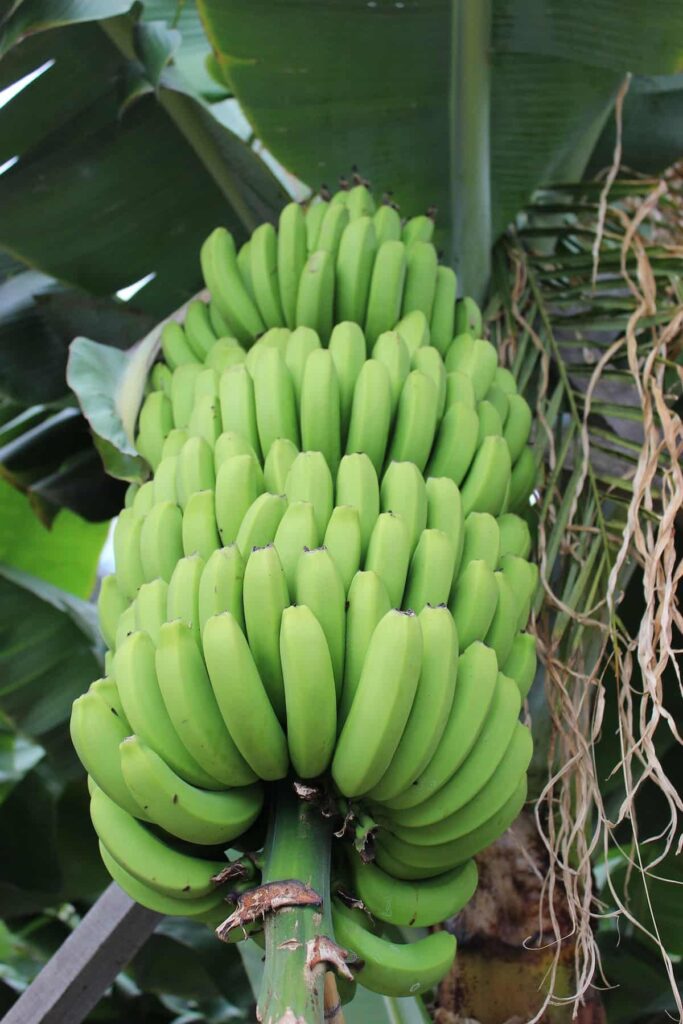
Organic Banana farming in the Philippines
- The Banana industry in the Philippines is growing rapidly, with organic Banana farming being a popular option for farmers. There are several benefits to choosing organic farming methods for Bananas, including improved soil quality and increased yields
- Organic farming techniques use natural means to improve soil quality, eliminating the need for fertilizer or other artificial additives. This can result in increased crop yields and a healthier environment. For example, bananas are heavy feeders and require plenty of fertile soil to produce healthy fruit; using organic methods helps ensure that the nutrients essential to their growth are available.
- Banana growers in the Philippines also face challenges unique to their climate and geography. The region experiences dry and wet seasons, which can strongly affect Banana production. Organic farming can help counteract these fluctuations by maintaining even moisture levels across the field throughout the year.
Banana pests, diseases, and their control in the Philippines
Several Banana pests can affect a Banana crop in the Philippines. The red palm weevil is the most common, which damages leaf tissues. Other pests that can attack Bananas include thrips, aphids, and whiteflies. In addition, diseases that affect Bananas can be spread by vectors such as mosquitoes or wind. Various ways to control these pests and diseases include using pesticides, hand-picking, exposing plants to cold weather, or installing mesh screens.
Banana farming challenges in the Philippines
- Banana farmers face several challenges when cultivating Bananas commercially. The biggest challenge is finding sufficient land to grow Bananas on; farmers need at least 8 hectares per hectare of the Banana crop to be profitable. In addition, proper watering and fertilization regimes are necessary to ensure optimal Banana production. Pests and diseases also pose a major threat to Banana farming.
- One significant obstacle is the lack of buyers for Philippine Bananas overseas. This lack of demand has led to low prices for Filipino Bananas and threatens the livelihoods of Banana farmers. Policies must be implemented to support this sector to increase the demand for Philippine Bananas and protect the livelihoods of Banana farmers.
- Due to pests and diseases, climatic factors, and inadequate infrastructure and tools, Banana farming has faced challenges. Bananas are susceptible to several pests and diseases, including black Sigatoka, yellow rust, Banana bunched virus disease (BBDV), fusarium wilt, and black Sigatoka virus. Climatic factors can affect Banana yields, including draughtiness and severe droughts. Inadequate infrastructure and tools can limit farmers’ abilities to manage their resources effectively.
- The government has launched several initiatives to address these challenges over the past few years. These include Project Banana Laban (PBL), which provides training on best practices for Banana cultivation; Project Bananas for Good (PB4G), which promotes sustainable Banana production through improved farm management techniques; and the National Banana Research Institute (NBRI), which researches various aspects of Banana cultivation.
- Despite these efforts, Bananas continue to face challenges in the Philippines. However, with concerted government effort and support from private industry players, Banana farming may continue to become a major economic sector in the country.
In case you missed it: Dwarf Banana Farming -Plantation In India
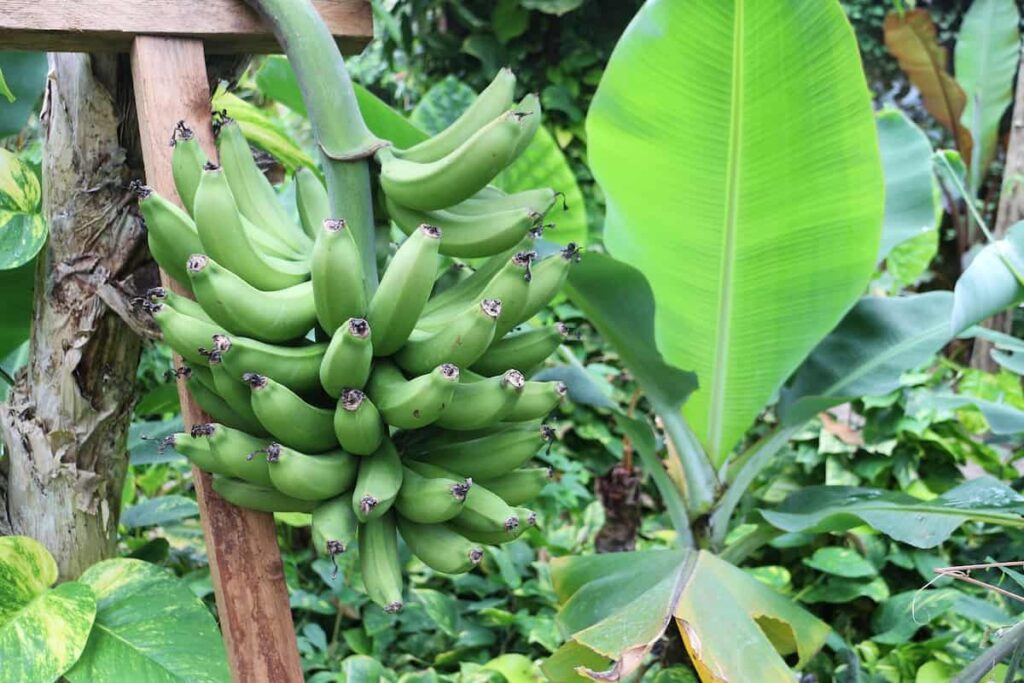
Banana marketing in the Philippines
Banana marketing in the Philippines is a growing industry, with exports expected to grow by about 14% annually. The main buyers of Philippine Bananas are countries in Southeast Asia, such as Vietnam, Cambodia, and Thailand, where they are used as ingredients in various dishes. Other countries that purchase Philippine Bananas include Indonesia, Malaysia, and Brunei. In addition to being used as ingredients in food products, Bananas are also processed into biofuels such as ethanol and biodiesel.
Conclusion
The climate in the Philippines is perfect for growing Bananas. The soil is fertile, and the temperature is warm all year long. There is no need for irrigation because the rainfall provides enough water to grow Bananas. The Banana industry in the Philippines is growing quickly because there is a high demand for Bananas throughout Asia. The Banana industry in the Philippines has created many jobs and helped improve the country’s economy.
- Types of Pesticides Used in Agriculture: A Beginner’s Guide
- Economical Aquaculture: A Guide to Low-Budget Fish Farming
- 15 Common Planting Errors That Can Doom Your Fruit Trees
- How to Make Houseplants Bushy: Effective Tips and Ideas
- Innovative Strategies for Boosting Coconut Pollination and Yield
- Pollination Strategies for Maximum Pumpkin Yield
- The Complete Guide to Chicken Fattening: Strategies for Maximum Growth
- Natural Solutions for Tulip Problems: 100% Effective Remedies for Leaf and Bulb-Related Issues
- Revolutionizing Citrus Preservation: Towards a Healthier, Greener Future
- Natural Solutions for Peony Leaf and Flower Problems: 100% Effective Remedies
- Maximizing Profits with Avocado Contract Farming in India: A Comprehensive Guide
- Natural Solutions for Hydrangea Problems: 100% Effective Remedies for Leaf and Flowers
- The Ultimate Guide to Choosing the Perfect Foliage Friend: Bringing Life Indoors
- From Sunlight to Sustainability: 15 Ways to Use Solar Technology in Agriculture
- The Ultimate Guide to Dong Tao Chicken: Exploring from History to Raising
- The Eco-Friendly Makeover: How to Convert Your Unused Swimming Pool into a Fish Pond
- Mastering the Art of Delaware Chicken Farming: Essentials for Healthy Backyard Flocks
- 20 Best Homemade Fertilizers for Money Plant: DIY Recipes and Application Methods
- How to Craft a Comprehensive Free-Range Chicken Farming Business Plan
- Brighten Your Flock: Raising Easter Egger Chickens for Beauty and Bounty
- How to Optimize Your Poultry Egg Farm Business Plan with These Strategies
- Subsidy for Spirulina Cultivation: How Indian Government Schemes Encouraging Spirulina Farmers
- Ultimate Guide to Raising Dominique Chickens: Breeding, Feeding, Egg-Production, and Care
- Mastering the Art of Raising Jersey Giant Chickens: Care, Feeding, and More
- Ultimate Guide to Raising Legbar Chickens: Breeding, Farming Practices, Diet, Egg-Production
- How to Raise Welsummer Chickens: A Comprehensive Guide for Beginners
- How to Protect Indoor Plants in Winter: A Comprehensive Guide
- Ultimate Guide to Grow Bag Gardening: Tips, Tricks, and Planting Ideas for Urban Gardeners
- Guide to Lotus Cultivation: How to Propagate, Plant, Grow, Care, Cost, and Profit
- Agriculture Drone Subsidy Scheme: Government Kisan Subsidy, License, and How to Apply Online
- Ultimate Guide to Raising Araucana Chickens: Breed Profile, Farming Economics, Diet, and Care
- Bringing Hydroponics to Classroom: Importance, Benefits of Learning for School Students
- Ultimate Guide to Raising Polish Chickens: Breed Profile, Farming Economics, Diet, and Care
- Ultimate Guide to Raising Australorp Chickens: Profile, Farming Economics, Egg Production, Diet, and Care
- Silkie Chicken Farming: Raising Practices, Varieties, Egg Production, Diet, and Care
- Sussex Chicken Farming: Raising Practices, Varieties, Egg Production, Diet and Care
This article is Awesome